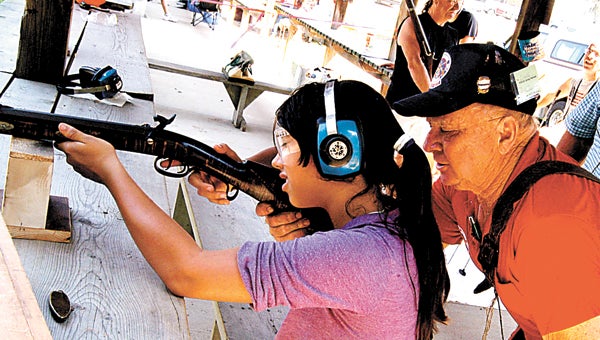Hunters teach ways to local youth
Published 5:10 pm Sunday, August 26, 2012

Leader photo/JOHN EBY Alexis Trowbridge, an eighth grader at St. Matthew Cathedral Catholic School in South Bend, Ind., has been shooting for three years, as she demonstrated Saturday by popping a target balloon at the River Valley Muzzleloaders booth of Saturday’s Edwardsburg Conservation Club Youth Day on Pine Lake Street.
Jack Heller can skin a muskrat in three minutes.
Practice makes perfect, and the trapper has been at it since 1968.
At Edwardsburg Conservation Club’s Youth Day Saturday, youngsters pawed through his mink, skunk, red fox and beaver hides.
They tried on his coonskin hat, which still had eyes and a face, and a coyote headdress, despite summer heat.
“If I see coyote tracks,” Heller said, “corn field, bean field, wherever I’m at, I’ll dig a little hole with a back behind it so he has to come around to the front to sniff. I wad up some weeds in the bottom of the hole, then I put mouse manure on it so it smells like a nest. I’ve got jars of it at home I’ve been saving for years. I dig out a trap bed and run a long, steel stake into the ground to hold him. This is a leg-hold trap, and yeah, I’ve sprung one on my hand before. It doesn’t feel good.”
Pre-cut wax papers are draped over the 1.5-inch pad to keep dirt from interfering with the $10 mechanism snapping shut.
“Sometimes, I just make a big bean mound from stalks and set a trap way up underneath,” Heller said. “It doesn’t break their legs, just pinches enough to hold them. You check traps every 24 hours. You have to have a license to trap; $15 lets you trap everything. No limit. You can start trapping at age 10.”
Heller boils his traps and lets them coat lightly with rust. Then he dyes them black and waxes them. The spray bottle in his tool kit contains fox urine.
“Coyotes hate fox. If they’re hungry, you can call coyotes in with mouse and rabbit distress, squeakers out of animal toys and turkey calls. Red fox are closer to town now, away from coyotes. They’re not out in farmland anymore.”
Heller reports that coyote pelts hit a high this past year, going for $22, $24, $26.
“It depends on the fur auction, what color they’re looking for. I’ve heard of them going for $50,” Heller said. “I heard China started buying a lot of fur last year. Usually our fur went to Europe, Russia. That’s who bought most U.S. fur for 20 to 30 years to make coats.
Trapping season runs from November until the end of March.
“Colder weather and dark nights prime the pelts,” he said. “No pelts are worth any money right now because it’s all summer hair. Deer are red right now and turn brown by fall. They shed to get winter coats, like birds moult.
“Once you’ve got coyotes, you can’t get rid of them,” said Heller, who lives north of Niles and grew up in Buchanan. “When I first started trapping, you never heard of coyotes. They move around and are getting more plentiful. We’re their only predators. Grey wolves kill them in the Upper Peninsula, but we don’t have any down here. Coyotes’ main diet is deer. I’ve seen packs of 11 or 12. They’re hunting a lot to feed that many animals. They mate for life, so they usually run in pairs.”
There is a fur buyer as close by as Mishawaka, Ind., who sends pelts to auction in Canada.
“I usually run 20 to 30 traps,” Heller said. “I’ve got over 300 in the shed. It depends on if I’m water trapping or land trapping.”






